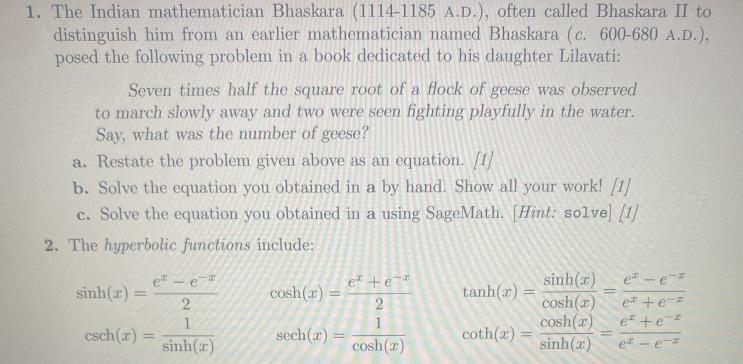Answered step by step
Verified Expert Solution
Question
1 Approved Answer
1. The Indian mathematician Bhaskara (1114-1185 A.D.), often called Bhaskara II to distinguish him from an earlier mathematician named Bhaskara (c. 600-680 A.D.), posed


1. The Indian mathematician Bhaskara (1114-1185 A.D.), often called Bhaskara II to distinguish him from an earlier mathematician named Bhaskara (c. 600-680 A.D.), posed the following problem in a book dedicated to his daughter Lilavati: Seven times half the square root of a flock of geese was observed to march slowly away and two were seen fighting playfully in the water. Say, what was the number of geese? a. Restate the problem given above as an equation. [1] b. Solve the equation you obtained in a by hand. Show all your work! [1] c. Solve the equation you obtained in a using SageMath. [Hint: solve] [1] 2. The hyperbolic functions include: sinh(): csch(x) = e-e 2 1 sinh(r) cosh(x) sech(z) = et te 2 1 cosh(x) tanh(z)= coth(x) sinh() cosh(x) cosh(a) sinh(r) = = et-e-x e +e e te et - e The names of these function are usually pronounced something like "sinch", "kosh", "tanch", "co-seech", "seech", and "kotch", respectively. They turn out to be closely re- lated to the natural exponential function (obviously) and the trigonometric functions; the latter connections being more obvious when you look at their series expansions and especially when you start looking at them as functions of a complex variable. a. Explain why -1 < tanh(z) < 1 for all a. [1] b. Use SageMath to compute lim tanh(r) and lim tanh(z). [Hint: 1im] [1] c. What does the information in a and b tell you about y = tanh(r)? What does it tell you about the inverse function, y = arctanh(r), of tanh(2)? [1/ d. Find a formula for arctanh(z) by hand. Show all your work. [1.5] e. Find a formula for arctanh(a) using SageMath. [Hint: solve] [1.5/ f. Use SageMath to graph both y = tanh(a) and y arctanh() in the same plot, for -2,5 SS 2.5 and -2.5 y 2.5. [Hint: Add the plots. Literally.] [1] inale pdf
Step by Step Solution
There are 3 Steps involved in it
Step: 1
Lets start by rephrasing the problem as an equation Let N be the number of geese The problem states that Seven times half the square root of a flock o...
Get Instant Access to Expert-Tailored Solutions
See step-by-step solutions with expert insights and AI powered tools for academic success
Step: 2

Step: 3

Ace Your Homework with AI
Get the answers you need in no time with our AI-driven, step-by-step assistance
Get Started


